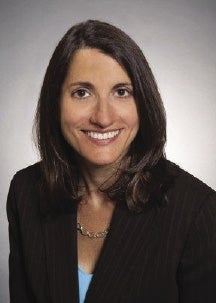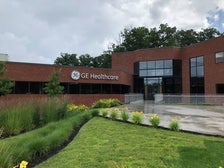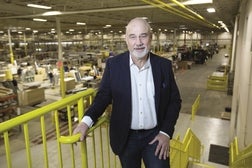Super-size the staff! GE division's arrival a study in team building
It's something we see more and more: companies packing up and moving to Marlborough, or choosing the area as the best place to launch a new venture.
Testing and diagnostic equipment maker Hologic did it this summer — moving its headquarters to Marlborough, hiring 150 additional employees. Last year, SanDisk of Milpitas, Calif., opened a new research and development facility on Donald Lynch Boulevard, adding 60 jobs. All this momentum built up to a crescendo, with Boston Scientific's huge move from Natick to Marlborough last year — bringing 800 jobs with it — and New Jersey-based Quest Diagnostics moving into the former Hewlett-Packard property at Forest Park in Marlborough.
Now, biotech giant GE Healthcare Life Sciences is about to set up shop at the Forest Park complex, moving its U.S. headquarters from Piscataway, N.J., to Marlborough.
Relocating, laying off, hiring and onboarding so many employees are no easy tasks for these firms that now call MetroWest home. But what if you have to do all three — as part of the same transition?
Numbers game
When the Marlborough GE Healthcare Life Sciences site is fully operational, it will house about 500 employees, including new positions and those that already existed. As of late July, 185 of the total 215 new jobs were filled, said Erica Bell, a human resources business partner coordinating GE's site move. Most of the new positions are in pharmacovigilance, which refers to monitoring the effects of drugs after they are licensed; regulatory affairs; and the commercial operations team for the company's contrast media business, she said.
One-hundred and twenty jobs are moving from within Massachusetts (GE already has a Westborough location). About 50 to 70 employees are making the move to Marlborough from New Jersey. And in terms of growth, about 100 more jobs are expected when the site is up to full capacity in 2017, after an occupancy permit is granted this year and labs are built in two phases over the next two years.
With such an epic reshuffling — New Jersey employees relocating, declining to do so, or being laid off — and such a large amount of new hires needed, where does a company begin?
They begin early, for one thing, said Bell, and they begin internally. “We started last summer, putting a staffing strategy together, looking at the business,” said Bell.
This kind of early start in hiring is crucial, says Brendon Davis, president of The Davis Companies, a Marlborough-based staffing services firm.
Staffing spillover
“(The) biggest successes come when we're brought in early to the table to discuss whether they should even look at this area, where the pockets of talent will be” for a particular industry, Davis said. Though the company did not assist in the GE staffing project, Davis is accustomed to large hiring endeavors. In 2012-2013, for instance, Davis helped office supply giant Staples in Framingham ramp up its employee base by 1,500 sales representatives for its new, in-store cell phone service.
To gear up, Davis said, the staffing firm had to do some staffing of its own.
“We hired, internally, five to 10 contract recruiters,” he said. In cases of mega-hiring situations such as Staples or GE Healthcare Services, staffing firms have to be agile, he said, “so that we can scale up, we have relationships with recruiters in the area,” who are ready to go, he said.
KNF&T Staffing Resources Vice President Beth Cabrera agrees, and takes early involvement one step further to ensure this ground-floor advantage — for best results. Her firm, with offices in Westborough, reaches out to companies before they need to hire. KNF&T looks for companies with these characteristics: great growth; being on the verge of an acquisition or merger; grant applications to help fund expansion, or in the case of biotech, FDA approvals — “anything that may change their staffing picture,” Cabrera says. “We make suggestions on market trends … Staffing (needs) may change before they know it.”
HR in hyperdrive
GE Healthcare Life Services' staffing plan was in place by mid-August of 2014, well before the company's move to Marlborough was announced in January of this year. It began doubling its new-hire referral bonus to existing employees who may know of potential hires in Massachusetts. Then word went out through social media, career fairs and media outreach. There were specialty roles to fill for which Bell partnered with recruiters, she said, in areas such as tech research and development; and specific marketing roles that required a tech background.
By the start of 2015, many roles were filled already, said Bell. “We got very lucky at timing,” she said. “There was not a lot of hiring going on. We manipulated the market, so to speak.”
Timing is important. But an understanding of the labor market from a compensation standpoint is sometimes a challenge in the staffing process, said Davis of Davis Companies, especially when out-of-area firms move in. Companies might have a salary in mind for a position, but that number may not be anywhere near the average salary in that market at that time.
If the job is publicized at the lower rate, it can turn off potential employees and give the impression that whoever is responsible for staffing is not doing their job, an obstacle to efficient hiring. “It's sometimes surprising,” Davis said. “You might have someone up top who doesn't see what the market looks like; there is a salary budgeted. They're yelling at HR to say, 'We're not seeing resumes.' It looks like they aren't producing.”
Getting in front of it
Another crucial step for GE Healthcare Life Sciences was to begin to wrap things up at the closing New Jersey site.
Long before site selection began in Massachusetts, the company started notifying employees in New Jersey of jobs being eliminated, changed or added, said Bell. The goal was transparency. “They knew for six to seven months,” she said. “Some had long GE careers, some were looking for something different. We had to make sure we met those needs.”
Then came time to build teams in Marlborough. “We formed a Team Building Engagement Committee,” said Bell, “with a handful of employees from (the) Marlborough and Westborough sites.”
To fill remaining positions at GE Healthcare Life Sciences, Bell said, the company continues to interview each week and bring new employees on board every two weeks. The company has temporary digs across the street from its permanent, 160-thousand-square-foot facility in Marlborough, while renovations are underway. GE hopes to be in its new space by the end of 2015 or early 2016.
Other obstacles
Though Bell said GE Healthcare Life Sciences has had luck hiring in Massachusetts, Davis said that the STEM skills gap is still an issue for many companies. His firm invests in “crunching big data,” to target where the talent is. For every 10 CNC (computer numerical control) machinist positions, for example, Davis says there is one candidate, on average.
Cabrera calls one remedy “looking past the paper”: focusing not on what a candidate's resume lacks, but on how to get the candidate trained in needed skills.
Some GE job-seekers, of course, have come from competitors. This, says Davis, is again where market-accurate salaries come into play.
Employee engagement, too, is important during transitions such as GE Healthcare Life Science's move to MetroWest, said Bell. “It's really how you treat employees.”

















0 Comments